oil temperature Seat Leon SC 2014 Owner's manual
[x] Cancel search | Manufacturer: SEAT, Model Year: 2014, Model line: Leon SC, Model: Seat Leon SC 2014Pages: 284, PDF Size: 5.85 MB
Page 21 of 284
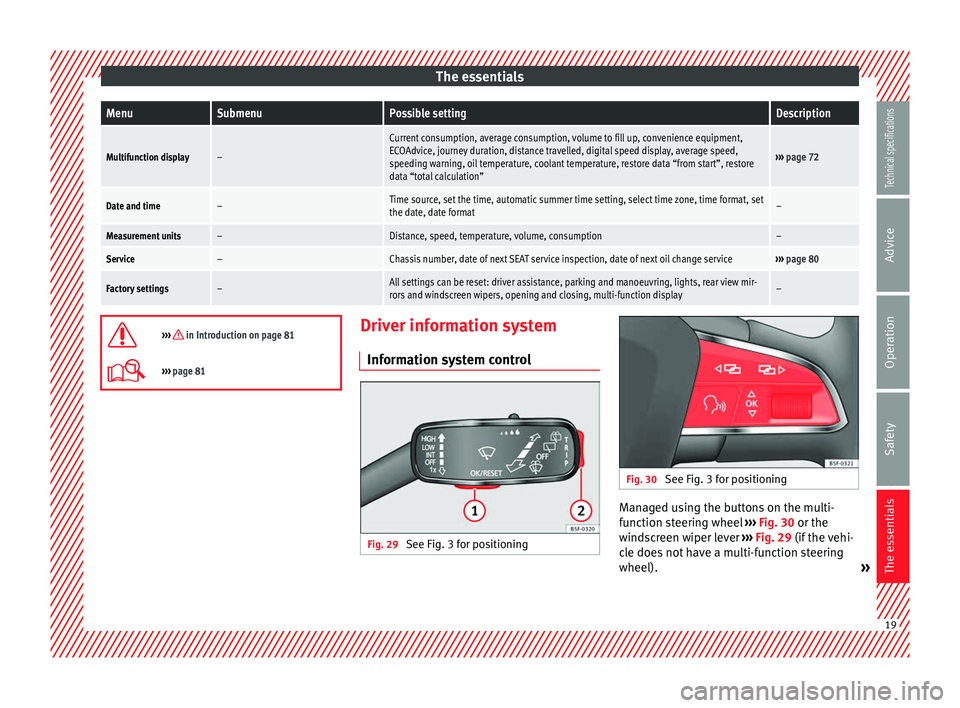
The essentialsMenuSubmenuPossible settingDescription
Multifunction display–
Current consumption, average consumption, volume to fill up, convenience equipment,
ECOAdvice, journey duration, distance travelled, digital speed display, average speed,
speeding warning, oil temperature, coolant temperature, restore data “from start”, restore
data “total calculation”
›››
page 72
Date and time–Time source, set the time, automatic summer time setting, select time zone, time format, set
the date, date format–
Measurement units–Distance, speed, temperature, volume, consumption–
Service–Chassis number, date of next SEAT service inspection, date of next oil change service››› page 80
Factory settings–All settings can be reset: driver assistance, parking and manoeuvring, lights, rear view mir-
rors and windscreen wipers, opening and closing, multi-function display–
››› in Introduction on page 81
›››
page 81 Driver information system
Information system control Fig. 29
See Fig. 3 for positioning Fig. 30
See Fig. 3 for positioning Managed using the buttons on the multi-
function steering wheel
››› Fig. 30 or the
w ind
screen wiper lever ››› Fig. 29 (if the vehi-
cle does not have a multi-function steering
wheel). » 19
Technical specifications
Advice
Operation
Safety
The essentials
Page 25 of 284
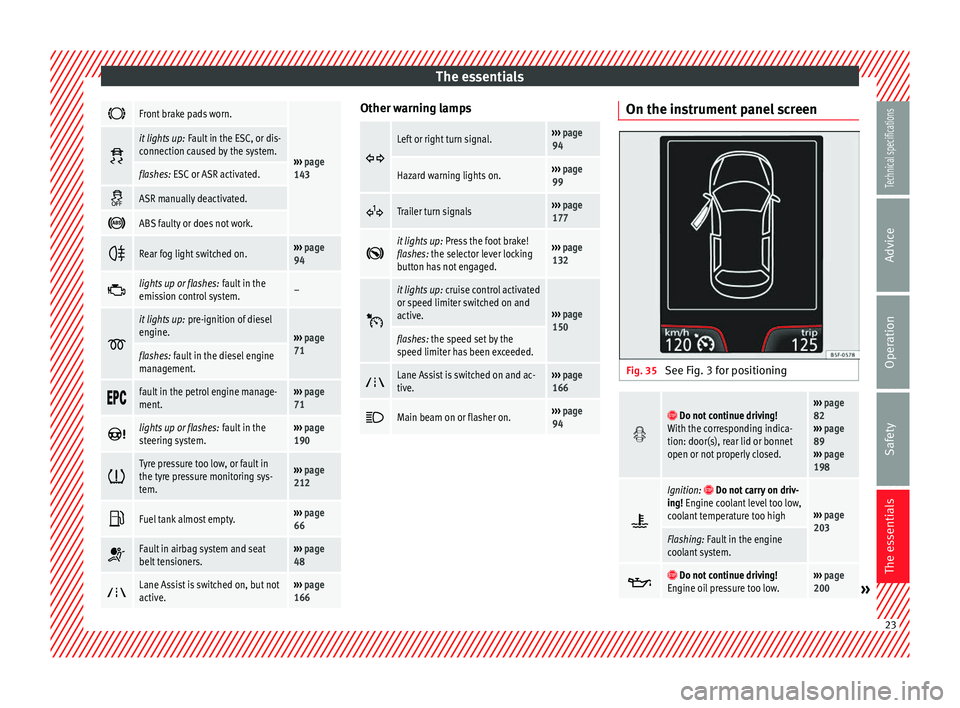
The essentials
Front brake pads worn.
›››
page
143
it lights up:
Fault in the ESC, or dis-
connection caused by the system.
flashes: ESC or ASR activated.
ASR manually deactivated.
ABS faulty or does not work.
Rear fog light switched on.›››
page
94
lights up or flashes:
fault in the
emission control system.–
it lights up:
pre-ignition of diesel
engine.
››› page
71
flashes: fault in the diesel engine
management.
fault in the petrol engine manage-
ment.›››
page
71
lights up or flashes:
fault in the
steering system.››› page
190
Tyre pressure too low, or fault in
the tyre pressure monitoring sys-
tem.›››
page
212
Fuel tank almost empty.›››
page
66
Fault in airbag system and seat
belt tensioners.›››
page
48
Lane Assist is switched on, but not
active.›››
page
166 Other warning lamps
Left or right turn signal.›››
page
94
Hazard warning lights on.››› page
99
Trailer turn signals›››
page
177
it lights up:
Press the foot brake!
flashes: the selector lever locking
button has not engaged.››› page
132
it lights up:
cruise control activated
or speed limiter switched on and
active.
››› page
150
flashes: the speed set by the
speed limiter has been exceeded.
Lane Assist is switched on and ac-
tive.›››
page
166
Main beam on or flasher on.›››
page
94 On the instrument panel screen
Fig. 35
See Fig. 3 for positioning Do not continue driving!
With the corresponding indica-
tion: door(s), rear lid or bonnet
open or not properly closed.››› page
82
››› page
89
››› page
198
Ignition: Do not carry on driv-
ing! Engine coolant level too low,
coolant temperature too high
››› page
203
Flashing: Fault in the engine
coolant system.
Do not continue driving!
Engine oil pressure too low.››› page
200» 23
Technical specifications
Advice
Operation
Safety
The essentials
Page 26 of 284
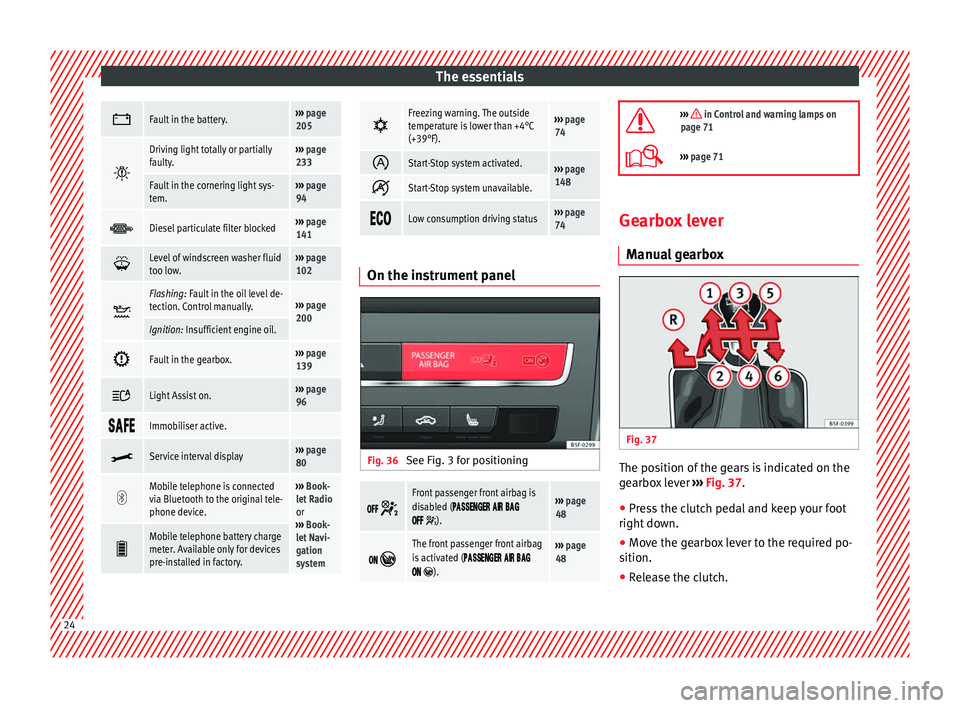
The essentials
Fault in the battery.›››
page
205
Driving light totally or partially
faulty.›››
page
233
Fault in the cornering light sys-
tem.››› page
94
Diesel particulate filter blocked›››
page
141
Level of windscreen washer fluid
too low.›››
page
102
Flashing: Fault in the oil level de-
tection. Control manually.›››
page
200
Ignition: Insufficient engine oil.
Fault in the gearbox.›››
page
139
Light Assist on.›››
page
96
Immobiliser active.
Service interval display›››
page
80
Mobile telephone is connected
via Bluetooth to the original tele-
phone device.›››
Book-
let Radio
or
››› Book-
let Navi-
gation
system
Mobile telephone battery charge
meter. Available only for devices
pre-installed in factory.
Freezing warning. The outside
temperature is lower than +4°C
(+39°F).›››
page
74
Start-Stop system activated.›››
page
148
Start-Stop system unavailable.
Low consumption driving status›››
page
74 On the instrument panel
Fig. 36
See Fig. 3 for positioning
Front passenger front airbag is
disabled (
).
››› page
48
The front passenger front airbag
is activated (
).
››› page
48
››› in Control and warning lamps on
page 71
››› page 71 Gearbox lever
Manual gearbox Fig. 37
The position of the gears is indicated on the
gearbox lever
››› Fig. 37 .
● Pr e
ss the clutch pedal and keep your foot
right down.
● Move the gearbox lever to the required po-
sition.
● Release the clutch. 24
Page 72 of 284
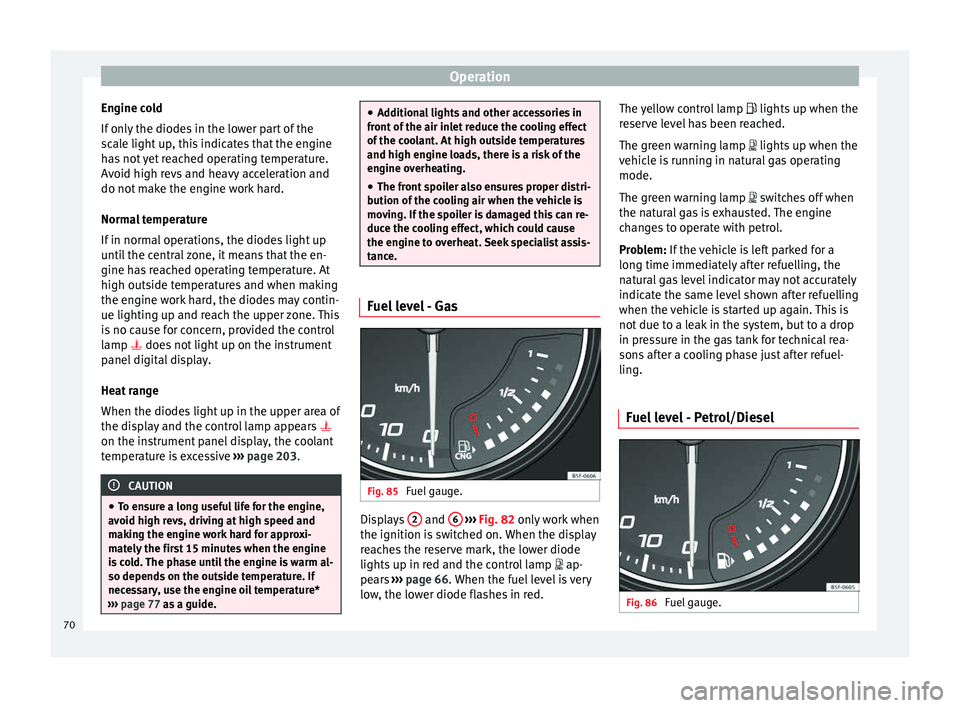
Operation
Engine cold
If only the diodes in the lower part of the
scale light up, this indicates that the engine
has not yet reached operating temperature.
Avoid high revs and heavy acceleration and
do not make the engine work hard.
Normal temperature
If in normal operations, the diodes light up
until the central zone, it means that the en-
gine has reached operating temperature. At
high outside temperatures and when making
the engine work hard, the diodes may contin-
ue lighting up and reach the upper zone. This
is no cause for concern, provided the control
lamp does not light up on the instrument
panel digital display.
Heat range
When the diodes light up in the upper area of
the display and the control lamp appears
on the instrument panel display, the coolant
temperature is excessive ››› page 203. CAUTION
● To ensure a long useful life for the engine,
avoid high revs, driving at high speed and
making the engine work hard for approxi-
mately the first 15 minutes when the engine
is cold. The phase until the engine is warm al-
so depends on the outside temperature. If
necessary, use the engine oil temperature*
››› page 77 as a guide. ●
Additional lights and other accessories in
front of the air inlet reduce the cooling effect
of the coolant. At high outside temperatures
and high engine loads, there is a risk of the
engine overheating.
● The front spoiler also ensures proper distri-
bution of the cooling air when the vehicle is
moving. If the spoiler is damaged this can re-
duce the cooling effect, which could cause
the engine to overheat. Seek specialist assis-
tance. Fuel level - Gas
Fig. 85
Fuel gauge. Displays
2 and
6
››› Fig. 82 only work when
the ignition i s
switched on. When the display
reaches the reserve mark, the lower diode
lights up in red and the control lamp ap-
pears ››› page 66. When the fuel level is very
low
, the lower diode flashes in red. The yellow control lamp
lights up when the
reserve level has been reached.
The green warning lamp
lights up when the
vehicle is running in natural gas operating
mode.
The green warning lamp
switches off when
the natural gas is exhausted. The engine
changes to operate with petrol.
Problem:
If the vehicle is left parked for a
long time immediately after refuelling, the
natural gas level indicator may not accurately
indicate the same level shown after refuelling
when the vehicle is started up again. This is
not due to a leak in the system, but to a drop
in pressure in the gas tank for technical rea-
sons after a cooling phase just after refuel-
ling.
Fuel level - Petrol/Diesel Fig. 86
Fuel gauge.70
Page 79 of 284
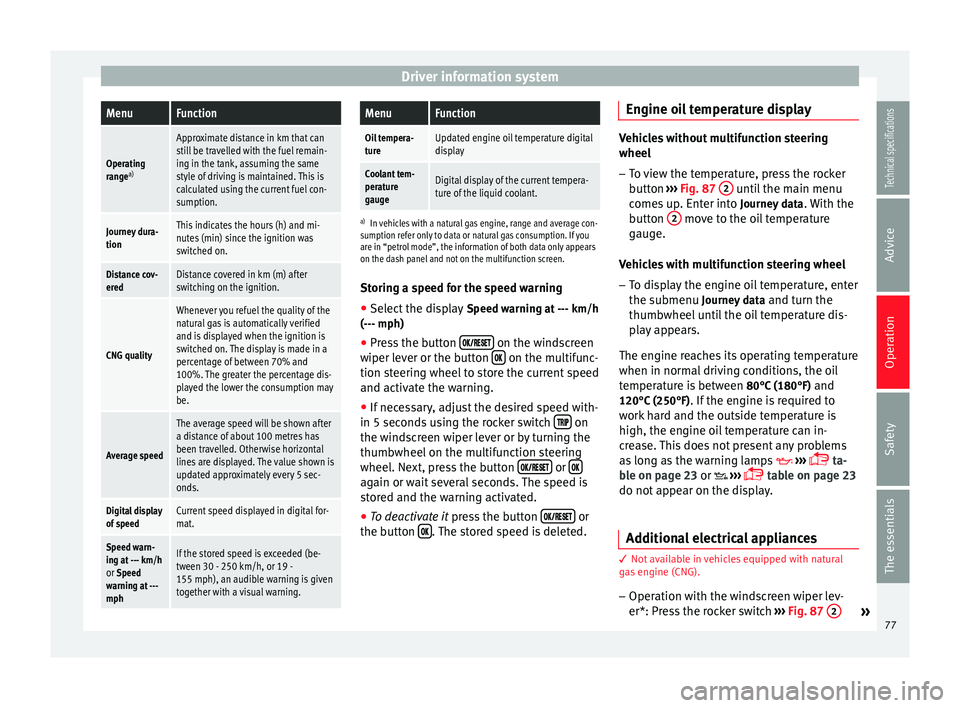
Driver information systemMenuFunction
Operating
range
a)
Approximate distance in km that can
still be travelled with the fuel remain-
ing in the tank, assuming the same
style of driving is maintained. This is
calculated using the current fuel con-
sumption.
Journey dura-
tionThis indicates the hours (h) and mi-
nutes (min) since the ignition was
switched on.
Distance cov-
eredDistance covered in km (m) after
switching on the ignition.
CNG quality
Whenever you refuel the quality of the
natural gas is automatically verified
and is displayed when the ignition is
switched on. The display is made in a
percentage of between 70% and
100%. The greater the percentage dis-
played the lower the consumption may
be.
Average speed
The average speed will be shown after
a distance of about 100 metres has
been travelled. Otherwise horizontal
lines are displayed. The value shown is
updated approximately every 5 sec-
onds.
Digital display
of speedCurrent speed displayed in digital for-
mat.
Speed warn-
ing at --- km/h
or Speed warning at ---
mphIf the stored speed is exceeded (be-
tween 30 - 250 km/h, or 19 -
155 mph), an audible warning is given
together with a visual warning.
MenuFunction
Oil tempera-
tureUpdated engine oil temperature digital
display
Coolant tem-
perature
gaugeDigital display of the current tempera-
ture of the liquid coolant.
a) In vehicles with a natural gas engine, range and average con-
sumption refer only to data or natural gas consumption. If you
are in “petrol mode”, the information of both data only appears
on the dash panel and not on the multifunction screen.
Storing a speed for the speed warning
● Select the display Speed warning at --- km/h
(--- mph)
● Press the button on the windscreen
wiper lever or the button on the multifunc-
tion steering wheel to store the current speed
and activate the warning.
● If necessary, adjust the desired speed with-
in 5 seconds using the rocker switch on
the windscreen wiper lever or by turning the
thumbwheel on the multifunction steering
wheel. Next, press the button or
again or wait several seconds. The speed is
stored and the warning activated.
● To deactivate it press the button
or
the button . The stored speed is deleted.Engine oil temperature display Vehicles without multifunction steering
wheel
– To view the temperature, press the rocker
button ››› Fig. 87 2 until the main menu
comes up. Enter into Journey data. With the
button 2 move to the oil temperature
gauge.
Vehicles with multifunction steering wheel
– To display the engine oil temperature, enter
the submenu Journey data and turn the
thumbwheel until the oil temperature dis-
play appears.
The engine reaches its operating temperature
when in normal driving conditions, the oil
temperature is between 80°C (180°F)
and
120°C (250°F) . If the engine is required to
work hard and the outside temperature is
high, the engine oil temperature can in-
crease. This does not present any problems
as long as the warning lamps ›››
ta-
ble on page 23 or ››
›
table on page 23
do not appear on the display.
Additional electrical appliances 3 Not available in vehicles equipped with natural
gas engine (CNG).
– Operation with the windscreen wiper lev-
er*: Press the rocker switch ›››
Fig. 87 2 »
77
Technical specifications
Advice
Operation
Safety
The essentials
Page 132 of 284
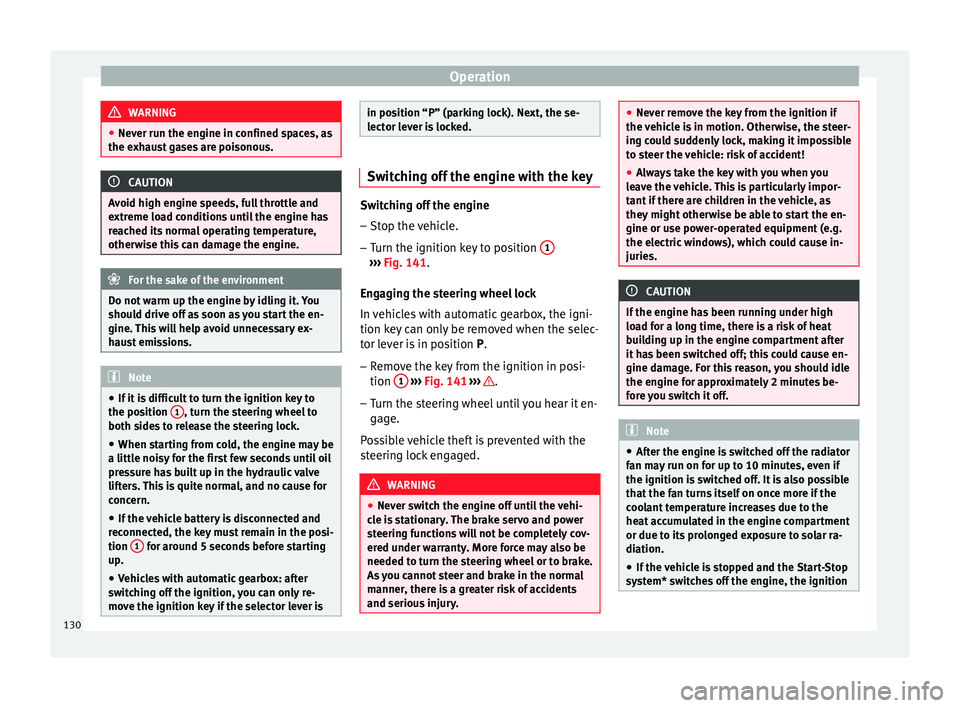
Operation
WARNING
● Never run the engine in confined spaces, as
the exhaust gases are poisonous. CAUTION
Avoid high engine speeds, full throttle and
extreme load conditions until the engine has
reached its normal operating temperature,
otherwise this can damage the engine. For the sake of the environment
Do not warm up the engine by idling it. You
should drive off as soon as you start the en-
gine. This will help avoid unnecessary ex-
haust emissions. Note
● If it is difficult to turn the ignition key to
the position 1 , turn the steering wheel to
both sides to release the steering lock.
● When starting from cold, the engine may be
a little noisy for the first few seconds until oil
pressure has built up in the hydraulic valve
lifters. This is quite normal, and no cause for
concern.
● If the vehicle battery is disconnected and
reconnected, the key must remain in the posi-
tion 1 for around 5 seconds before starting
up.
● Vehicles with automatic gearbox: after
switching off the ignition, you can only re-
move the ignition key if the selector lever is in position “P” (parking lock). Next, the se-
lector lever is locked.
Switching off the engine with the key
Switching off the engine
– Stop the vehicle.
– Turn the ignition key to position 1 ›››
Fig. 141.
En g
aging the steering wheel lock
In vehicles with automatic gearbox, the igni-
tion key can only be removed when the selec-
tor lever is in position P.
– Remo
ve the key from the ignition in posi-
tion 1
››› Fig. 141
›
›› .
– Turn the steering wheel until you hear it en-
gage.
Possible vehicle theft is prevented with the
steering lock engaged. WARNING
● Never switch the engine off until the vehi-
cle is stationary. The brake servo and power
steering functions will not be completely cov-
ered under warranty. More force may also be
needed to turn the steering wheel or to brake.
As you cannot steer and brake in the normal
manner, there is a greater risk of accidents
and serious injury. ●
Never remove the key from the ignition if
the vehicle is in motion. Otherwise, the steer-
ing could suddenly lock, making it impossible
to steer the vehicle: risk of accident!
● Always take the key with you when you
leave the vehicle. This is particularly impor-
tant if there are children in the vehicle, as
they might otherwise be able to start the en-
gine or use power-operated equipment (e.g.
the electric windows), which could cause in-
juries. CAUTION
If the engine has been running under high
load for a long time, there is a risk of heat
building up in the engine compartment after
it has been switched off; this could cause en-
gine damage. For this reason, you should idle
the engine for approximately 2 minutes be-
fore you switch it off. Note
● After the engine is switched off the radiator
fan may run on for up to 10 minutes, even if
the ignition is switched off. It is also possible
that the fan turns itself on once more if the
coolant temperature increases due to the
heat accumulated in the engine compartment
or due to its prolonged exposure to solar ra-
diation.
● If the vehicle is stopped and the Start-Stop
system* switches off the engine, the ignition 130
Page 203 of 284
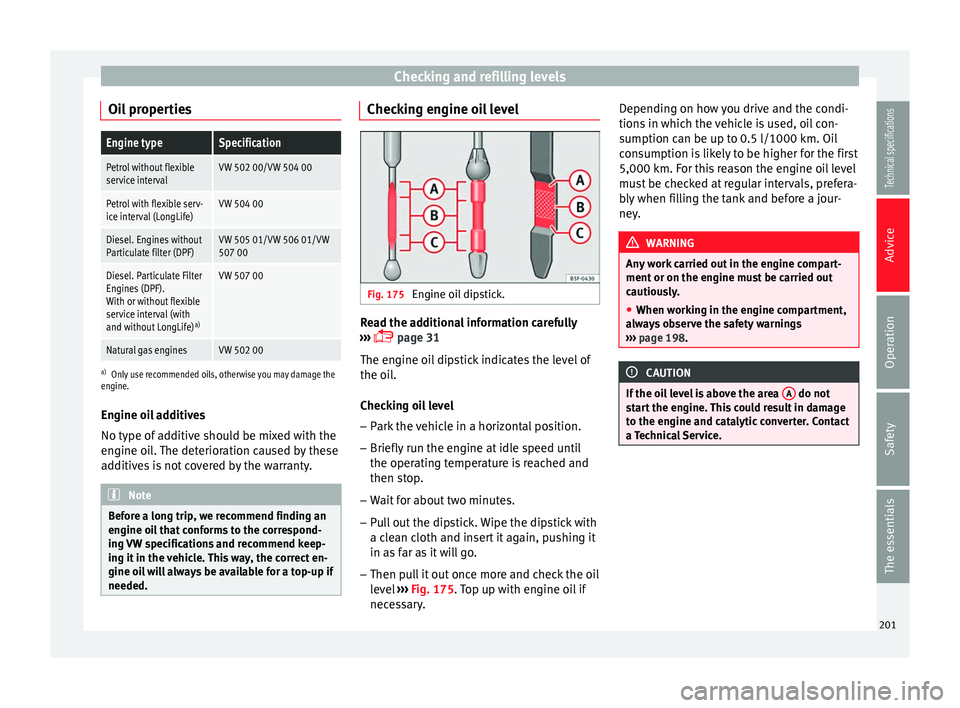
Checking and refilling levels
Oil propertiesEngine typeSpecification
Petrol without flexible
service intervalVW 502 00/VW 504 00
Petrol with flexible serv-
ice interval (LongLife)VW 504 00
Diesel. Engines without
Particulate filter (DPF)VW 505 01/VW 506 01/VW
507 00
Diesel. Particulate Filter
Engines (DPF).
With or without flexible
service interval (with
and without LongLife) a)VW 507 00
Natural gas enginesVW 502 00
a)
Only use recommended oils, otherwise you may damage the
engine.
Engine oil additives
No type of additive should be mixed with the
engine oil. The deterioration caused by these
additives is not covered by the warranty. Note
Before a long trip, we recommend finding an
engine oil that conforms to the correspond-
ing VW specifications and recommend keep-
ing it in the vehicle. This way, the correct en-
gine oil will always be available for a top-up if
needed. Checking engine oil level
Fig. 175
Engine oil dipstick. Read the additional information carefully
››› page 31
The engine oil dipstick indicates the level of
the oil.
Checking oil level
– Park the vehicle in a horizontal position.
– Briefly run the engine at idle speed until
the operating temperature is reached and
then stop.
– Wait for about two minutes.
– Pull out the dipstick. Wipe the dipstick with
a clean cloth and insert it again, pushing it
in as far as it will go.
– Then pull it out once more and check the oil
level ››› Fig. 175 . Top up with engine oil if
nec e
ssary. Depending on how you drive and the condi-
tions in which the vehicle is used, oil con-
sumption can be up to 0.5 l/1000 km. Oil
consumption is likely to be higher for the first
5,000 km. For this reason the engine oil level
must be checked at regular intervals, prefera-
bly when filling the tank and before a jour-
ney.
WARNING
Any work carried out in the engine compart-
ment or on the engine must be carried out
cautiously.
● When working in the engine compartment,
always observe the safety warnings
››› page 198. CAUTION
If the oil level is above the area A do not
start the engine. This could result in damage
to the engine and catalytic converter. Contact
a Technical Service. 201
Technical specifications
Advice
Operation
Safety
The essentials
Page 205 of 284
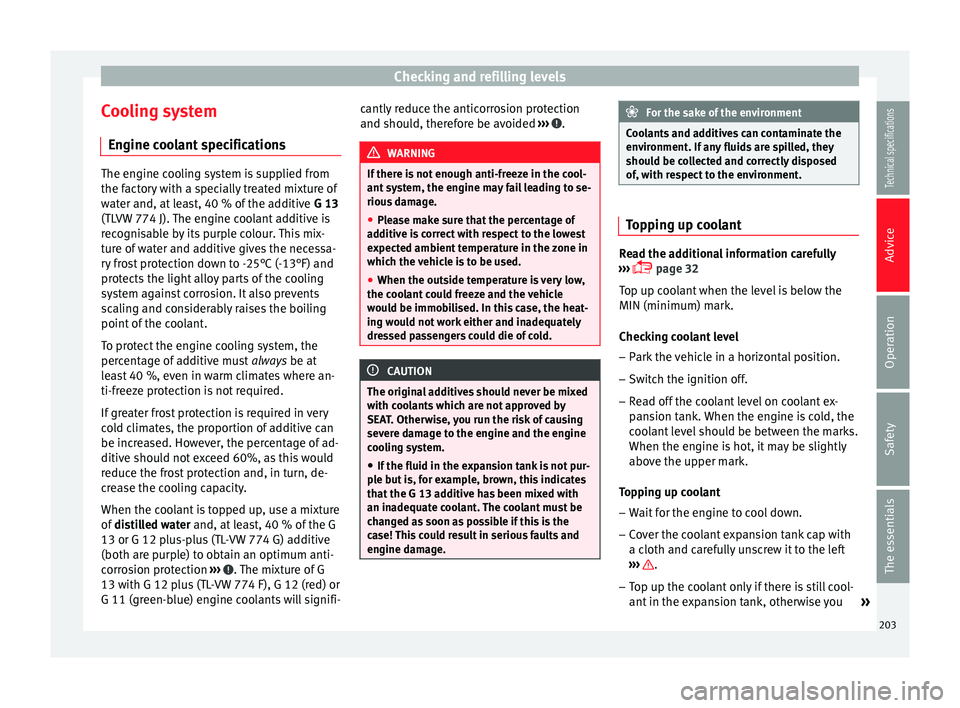
Checking and refilling levels
Cooling system Engine coolant specifications The engine cooling system is supplied from
the factory with a specially treated mixture of
water and, at least, 40 % of the additive
G 13
(TLVW 774 J). The engine coolant additive is
recognisable by its purple colour. This mix-
ture of water and additive gives the necessa-
ry frost protection down to -25°C (-13°F) and
protects the light alloy parts of the cooling
system against corrosion. It also prevents
scaling and considerably raises the boiling
point of the coolant.
To protect the engine cooling system, the
percentage of additive must always
be at
l e
ast 40 %, even in warm climates where an-
ti-freeze protection is not required.
If greater frost protection is required in very
cold climates, the proportion of additive can
be increased. However, the percentage of ad-
ditive should not exceed 60%, as this would
reduce the frost protection and, in turn, de-
crease the cooling capacity.
When the coolant is topped up, use a mixture
of distilled water and, at least, 40 % of the G
13 or G 12 plu
s-plus (TL-VW 774 G) additive
(both are purple) to obtain an optimum anti-
corrosion protection ››› . The mixture of G
13 with G 12 plus (TL-VW 774 F), G 12 (red) or
G 11 (green-blue) engine coolants will signifi- cantly reduce the anticorrosion protection
and should, therefore be avoided
››› .
WARNING
If there is not enough anti-freeze in the cool-
ant system, the engine may fail leading to se-
rious damage.
● Please make sure that the percentage of
additive is correct with respect to the lowest
expected ambient temperature in the zone in
which the vehicle is to be used.
● When the outside temperature is very low,
the coolant could freeze and the vehicle
would be immobilised. In this case, the heat-
ing would not work either and inadequately
dressed passengers could die of cold. CAUTION
The original additives should never be mixed
with coolants which are not approved by
SEAT. Otherwise, you run the risk of causing
severe damage to the engine and the engine
cooling system. ● If the fluid in the expansion tank is not pur-
ple but is, for example, brown, this indicates
that the G 13 additive has been mixed with
an inadequate coolant. The coolant must be
changed as soon as possible if this is the
case! This could result in serious faults and
engine damage. For the sake of the environment
Coolants and additives can contaminate the
environment. If any fluids are spilled, they
should be collected and correctly disposed
of, with respect to the environment. Topping up coolant
Read the additional information carefully
››› page 32
Top up coolant when the level is below the
MIN (minimum) mark.
Checking coolant level – Park the vehicle in a horizontal position.
– Switch the ignition off.
– Read off the coolant level on coolant ex-
pansion tank. When the engine is cold, the
coolant level should be between the marks.
When the engine is hot, it may be slightly
above the upper mark.
Topping up coolant – Wait for the engine to cool down.
– Cover the coolant expansion tank cap with
a cloth and carefully unscrew it to the left
››› .
– Top up the coolant only if there is still cool-
ant in the expansion tank, otherwise you »
203
Technical specifications
Advice
Operation
Safety
The essentials
Page 273 of 284
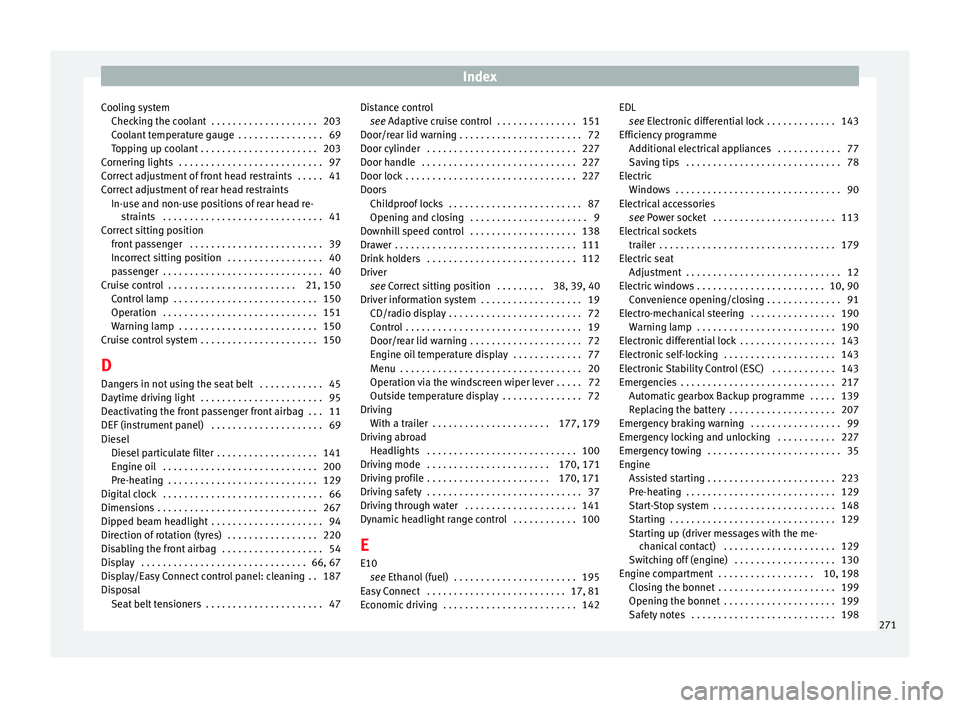
Index
Cooling system Checking the coolant . . . . . . . . . . . . . . . . . . . . 203
Coolant temperature gauge . . . . . . . . . . . . . . . . 69
Topping up coolant . . . . . . . . . . . . . . . . . . . . . . 203
Cornering lights . . . . . . . . . . . . . . . . . . . . . . . . . . . 97
Correct adjustment of front head restraints . . . . . 41
Correct adjustment of rear head restraints In-use and non-use positions of rear head re-straints . . . . . . . . . . . . . . . . . . . . . . . . . . . . . . 41
Correct sitting position front passenger . . . . . . . . . . . . . . . . . . . . . . . . . 39
Incorrect sitting position . . . . . . . . . . . . . . . . . . 40
passenger . . . . . . . . . . . . . . . . . . . . . . . . . . . . . . 40
Cruise control . . . . . . . . . . . . . . . . . . . . . . . . 21, 150 Control lamp . . . . . . . . . . . . . . . . . . . . . . . . . . . 150
Operation . . . . . . . . . . . . . . . . . . . . . . . . . . . . . 151
Warning lamp . . . . . . . . . . . . . . . . . . . . . . . . . . 150
Cruise control system . . . . . . . . . . . . . . . . . . . . . . 150
D Dangers in not using the seat belt . . . . . . . . . . . . 45
Daytime driving light . . . . . . . . . . . . . . . . . . . . . . . 95
Deactivating the front passenger front airbag . . . 11
DEF (instrument panel) . . . . . . . . . . . . . . . . . . . . . 69
Diesel Diesel particulate filter . . . . . . . . . . . . . . . . . . . 141
Engine oil . . . . . . . . . . . . . . . . . . . . . . . . . . . . . 200
Pre-heating . . . . . . . . . . . . . . . . . . . . . . . . . . . . 129
Digital clock . . . . . . . . . . . . . . . . . . . . . . . . . . . . . . 66
Dimensions . . . . . . . . . . . . . . . . . . . . . . . . . . . . . . 267
Dipped beam headlight . . . . . . . . . . . . . . . . . . . . . 94
Direction of rotation (tyres) . . . . . . . . . . . . . . . . . 220
Disabling the front airbag . . . . . . . . . . . . . . . . . . . 54
Display . . . . . . . . . . . . . . . . . . . . . . . . . . . . . . . 66, 67
Display/Easy Connect control panel: cleaning . . 187
Disposal Seat belt tensioners . . . . . . . . . . . . . . . . . . . . . . 47 Distance control
see Adaptive cruise control . . . . . . . . . . . . . . . 151
Door/r e
ar lid warning . . . . . . . . . . . . . . . . . . . . . . . 72
Door cylinder . . . . . . . . . . . . . . . . . . . . . . . . . . . . 227
Door handle . . . . . . . . . . . . . . . . . . . . . . . . . . . . . 227
Door lock . . . . . . . . . . . . . . . . . . . . . . . . . . . . . . . . 227
Doors Childproof locks . . . . . . . . . . . . . . . . . . . . . . . . . 87
Opening and closing . . . . . . . . . . . . . . . . . . . . . . 9
Downhill speed control . . . . . . . . . . . . . . . . . . . . 138
Drawer . . . . . . . . . . . . . . . . . . . . . . . . . . . . . . . . . . 111
Drink holders . . . . . . . . . . . . . . . . . . . . . . . . . . . . 112
Driver see
Correct sitting position . . . . . . . . . 38, 39, 40
Driver information system . . . . . . . . . . . . . . . . . . . 19 CD/radio display . . . . . . . . . . . . . . . . . . . . . . . . . 72
Control . . . . . . . . . . . . . . . . . . . . . . . . . . . . . . . . . 19
Door/rear lid warning . . . . . . . . . . . . . . . . . . . . . 72
Engine oil temperature display . . . . . . . . . . . . . 77
Menu . . . . . . . . . . . . . . . . . . . . . . . . . . . . . . . . . . 20
Operation via the windscreen wiper lever . . . . . 72
Outside temperature display . . . . . . . . . . . . . . . 72
Driving With a trailer . . . . . . . . . . . . . . . . . . . . . . 177, 179
Driving abroad Headlights . . . . . . . . . . . . . . . . . . . . . . . . . . . . 100
Driving mode . . . . . . . . . . . . . . . . . . . . . . . 170, 171
Driving profile . . . . . . . . . . . . . . . . . . . . . . . 170, 171
Driving safety . . . . . . . . . . . . . . . . . . . . . . . . . . . . . 37
Driving through water . . . . . . . . . . . . . . . . . . . . . 141
Dynamic headlight range control . . . . . . . . . . . . 100
E
E10 see Ethanol (fuel) . . . . . . . . . . . . . . . . . . . . . . . 195
E a
sy Connect . . . . . . . . . . . . . . . . . . . . . . . . . . 17, 81
Economic driving . . . . . . . . . . . . . . . . . . . . . . . . . 142 EDL
see Electronic differential lock . . . . . . . . . . . . . 143
Effic iency
programme
Additional electrical appliances . . . . . . . . . . . . 77
Saving tips . . . . . . . . . . . . . . . . . . . . . . . . . . . . . 78
Electric Windows . . . . . . . . . . . . . . . . . . . . . . . . . . . . . . . 90
Electrical accessories see
Power socket . . . . . . . . . . . . . . . . . . . . . . . 113
Electrical sockets trailer . . . . . . . . . . . . . . . . . . . . . . . . . . . . . . . . . 179
Electric seat Adjustment . . . . . . . . . . . . . . . . . . . . . . . . . . . . . 12
Electric windows . . . . . . . . . . . . . . . . . . . . . . . . 10, 90 Convenience opening/closing . . . . . . . . . . . . . . 91
Electro-mechanical steering . . . . . . . . . . . . . . . . 190 Warning lamp . . . . . . . . . . . . . . . . . . . . . . . . . . 190
Electronic differential lock . . . . . . . . . . . . . . . . . . 143
Electronic self-locking . . . . . . . . . . . . . . . . . . . . . 143
Electronic Stability Control (ESC) . . . . . . . . . . . . 143
Emergencies . . . . . . . . . . . . . . . . . . . . . . . . . . . . . 217 Automatic gearbox Backup programme . . . . . 139
Replacing the battery . . . . . . . . . . . . . . . . . . . . 207
Emergency braking warning . . . . . . . . . . . . . . . . . 99
Emergency locking and unlocking . . . . . . . . . . . 227
Emergency towing . . . . . . . . . . . . . . . . . . . . . . . . . 35
Engine Assisted starting . . . . . . . . . . . . . . . . . . . . . . . . 223
Pre-heating . . . . . . . . . . . . . . . . . . . . . . . . . . . . 129
Start-Stop system . . . . . . . . . . . . . . . . . . . . . . . 148
Starting . . . . . . . . . . . . . . . . . . . . . . . . . . . . . . . 129
Starting up (driver messages with the me-chanical contact) . . . . . . . . . . . . . . . . . . . . . 129
Switching off (engine) . . . . . . . . . . . . . . . . . . . 130
Engine compartment . . . . . . . . . . . . . . . . . . 10, 198 Closing the bonnet . . . . . . . . . . . . . . . . . . . . . . 199
Opening the bonnet . . . . . . . . . . . . . . . . . . . . . 199
Safety notes . . . . . . . . . . . . . . . . . . . . . . . . . . . 198 271
Page 274 of 284
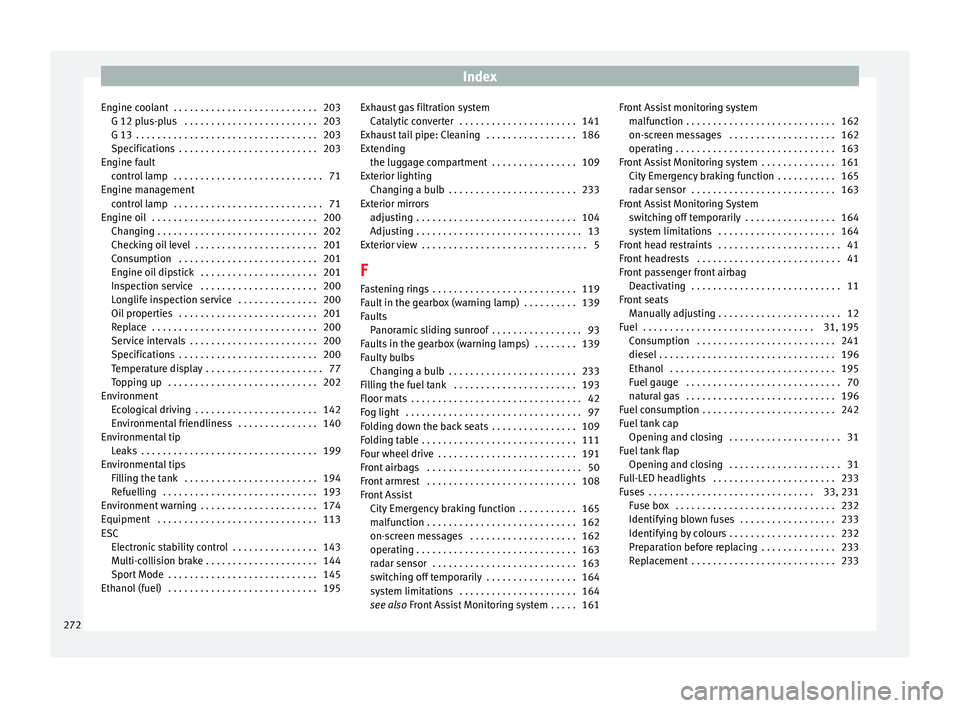
Index
Engine coolant . . . . . . . . . . . . . . . . . . . . . . . . . . . 203 G 12 plus-plus . . . . . . . . . . . . . . . . . . . . . . . . . 203
G 13 . . . . . . . . . . . . . . . . . . . . . . . . . . . . . . . . . . 203
Specifications . . . . . . . . . . . . . . . . . . . . . . . . . . 203
Engine fault control lamp . . . . . . . . . . . . . . . . . . . . . . . . . . . . 71
Engine management control lamp . . . . . . . . . . . . . . . . . . . . . . . . . . . . 71
Engine oil . . . . . . . . . . . . . . . . . . . . . . . . . . . . . . . 200 Changing . . . . . . . . . . . . . . . . . . . . . . . . . . . . . . 202
Checking oil level . . . . . . . . . . . . . . . . . . . . . . . 201
Consumption . . . . . . . . . . . . . . . . . . . . . . . . . . 201
Engine oil dipstick . . . . . . . . . . . . . . . . . . . . . . 201
Inspection service . . . . . . . . . . . . . . . . . . . . . . 200
Longlife inspection service . . . . . . . . . . . . . . . 200
Oil properties . . . . . . . . . . . . . . . . . . . . . . . . . . 201
Replace . . . . . . . . . . . . . . . . . . . . . . . . . . . . . . . 200
Service intervals . . . . . . . . . . . . . . . . . . . . . . . . 200
Specifications . . . . . . . . . . . . . . . . . . . . . . . . . . 200
Temperature display . . . . . . . . . . . . . . . . . . . . . . 77
Topping up . . . . . . . . . . . . . . . . . . . . . . . . . . . . 202
Environment Ecological driving . . . . . . . . . . . . . . . . . . . . . . . 142
Environmental friendliness . . . . . . . . . . . . . . . 140
Environmental tip Leaks . . . . . . . . . . . . . . . . . . . . . . . . . . . . . . . . . 199
Environmental tips Filling the tank . . . . . . . . . . . . . . . . . . . . . . . . . 194
Refuelling . . . . . . . . . . . . . . . . . . . . . . . . . . . . . 193
Environment warning . . . . . . . . . . . . . . . . . . . . . . 174
Equipment . . . . . . . . . . . . . . . . . . . . . . . . . . . . . . 113
ESC Electronic stability control . . . . . . . . . . . . . . . . 143
Multi-collision brake . . . . . . . . . . . . . . . . . . . . . 144
Sport Mode . . . . . . . . . . . . . . . . . . . . . . . . . . . . 145
Ethanol (fuel) . . . . . . . . . . . . . . . . . . . . . . . . . . . . 195 Exhaust gas filtration system
Catalytic converter . . . . . . . . . . . . . . . . . . . . . . 141
Exhaust tail pipe: Cleaning . . . . . . . . . . . . . . . . . 186
Extending the luggage compartment . . . . . . . . . . . . . . . . 109
Exterior lighting Changing a bulb . . . . . . . . . . . . . . . . . . . . . . . . 233
Exterior mirrors adjusting . . . . . . . . . . . . . . . . . . . . . . . . . . . . . . 104
Adjusting . . . . . . . . . . . . . . . . . . . . . . . . . . . . . . . 13
Exterior view . . . . . . . . . . . . . . . . . . . . . . . . . . . . . . . 5
F Fastening rings . . . . . . . . . . . . . . . . . . . . . . . . . . . 119
Fault in the gearbox (warning lamp) . . . . . . . . . . 139
Faults Panoramic sliding sunroof . . . . . . . . . . . . . . . . . 93
Faults in the gearbox (warning lamps) . . . . . . . . 139
Faulty bulbs Changing a bulb . . . . . . . . . . . . . . . . . . . . . . . . 233
Filling the fuel tank . . . . . . . . . . . . . . . . . . . . . . . 193
Floor mats . . . . . . . . . . . . . . . . . . . . . . . . . . . . . . . . 42
Fog light . . . . . . . . . . . . . . . . . . . . . . . . . . . . . . . . . 97
Folding down the back seats . . . . . . . . . . . . . . . . 109
Folding table . . . . . . . . . . . . . . . . . . . . . . . . . . . . . 111
Four wheel drive . . . . . . . . . . . . . . . . . . . . . . . . . . 191
Front airbags . . . . . . . . . . . . . . . . . . . . . . . . . . . . . 50
Front armrest . . . . . . . . . . . . . . . . . . . . . . . . . . . . 108
Front Assist City Emergency braking function . . . . . . . . . . . 165
malfunction . . . . . . . . . . . . . . . . . . . . . . . . . . . . 162
on-screen messages . . . . . . . . . . . . . . . . . . . . 162
operating . . . . . . . . . . . . . . . . . . . . . . . . . . . . . . 163
radar sensor . . . . . . . . . . . . . . . . . . . . . . . . . . . 163
switching off temporarily . . . . . . . . . . . . . . . . . 164
system limitations . . . . . . . . . . . . . . . . . . . . . . 164
see also Front Assist Monitoring system . . . . . 161 Fr
ont Assist monitoring system
malfunction . . . . . . . . . . . . . . . . . . . . . . . . . . . . 162
on-screen messages . . . . . . . . . . . . . . . . . . . . 162
operating . . . . . . . . . . . . . . . . . . . . . . . . . . . . . . 163
Front Assist Monitoring system . . . . . . . . . . . . . . 161 City Emergency braking function . . . . . . . . . . . 165
radar sensor . . . . . . . . . . . . . . . . . . . . . . . . . . . 163
Front Assist Monitoring System switching off temporarily . . . . . . . . . . . . . . . . . 164
system limitations . . . . . . . . . . . . . . . . . . . . . . 164
Front head restraints . . . . . . . . . . . . . . . . . . . . . . . 41
Front headrests . . . . . . . . . . . . . . . . . . . . . . . . . . . 41
Front passenger front airbag Deactivating . . . . . . . . . . . . . . . . . . . . . . . . . . . . 11
Front seats Manually adjusting . . . . . . . . . . . . . . . . . . . . . . . 12
Fuel . . . . . . . . . . . . . . . . . . . . . . . . . . . . . . . . 31, 195 Consumption . . . . . . . . . . . . . . . . . . . . . . . . . . 241
diesel . . . . . . . . . . . . . . . . . . . . . . . . . . . . . . . . . 196
Ethanol . . . . . . . . . . . . . . . . . . . . . . . . . . . . . . . 195
Fuel gauge . . . . . . . . . . . . . . . . . . . . . . . . . . . . . 70
natural gas . . . . . . . . . . . . . . . . . . . . . . . . . . . . 196
Fuel consumption . . . . . . . . . . . . . . . . . . . . . . . . . 242
Fuel tank cap Opening and closing . . . . . . . . . . . . . . . . . . . . . 31
Fuel tank flap Opening and closing . . . . . . . . . . . . . . . . . . . . . 31
Full-LED headlights . . . . . . . . . . . . . . . . . . . . . . . 233
Fuses . . . . . . . . . . . . . . . . . . . . . . . . . . . . . . . 33, 231 Fuse box . . . . . . . . . . . . . . . . . . . . . . . . . . . . . . 232
Identifying blown fuses . . . . . . . . . . . . . . . . . . 233
Identifying by colours . . . . . . . . . . . . . . . . . . . . 232
Preparation before replacing . . . . . . . . . . . . . . 233
Replacement . . . . . . . . . . . . . . . . . . . . . . . . . . . 233
272